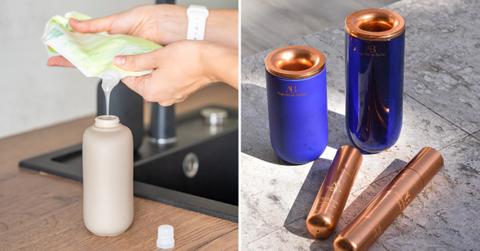Beauty Refill Packaging Isn't Always As Sustainable As It Seems (Exclusive)
"Often, a consumer needs to purchase a refill system four to five times before seeing any reduction in material use or carbon emissions."
Published July 31 2024, 12:26 p.m. ET

The cosmetics industry is soaring. From 2015 to 2022, e-commerce beauty sales quadrupled, and the industry is expected to see nearly $736 billion in global profits by 2028.
Beauty mavens are constantly buying what's hot, switching up their 10-step skincare routines, and keeping up with the revolving door of social media-based micro trends. Gone are the days of honoring holy grail products that work for you.
"Consumers aren’t repurchasing products at the same rate they used to," Allison Turquoise, a cosmetic packaging/formula sales director and educational content creator, exclusively tells Green Matters via email.
Modern-day beauty consumers are hardly brand loyal, but that hasn't stopped cosmetics giants from trialing methods for keeping folks around, often taking the sustainability route — and this is where cosmetic refill packaging comes in. But is a refillable cosmetic product actually as eco-friendly as the marketing claims?
"Refills have the potential to significantly reduce the amount of packaging material introduced into the market with each repurchase. However, their success is heavily dependent on two factors: Refill design and consumer purchasing behavior," Turquoise tells us.
Turquoise exclusively spoke to Green Matters about the realities of cosmetic refill packaging, specifically highlighting when systems are actually created with the planet in mind and when they're just another example of greenwashing.

Cosmetic refill packaging types: Allison Turquoise talks "bottle in a bottle" refill packaging vs. refill pouch packaging.
From Fenty to Sol de Janeiro to Valentino, some of the biggest brands are offering refill packaging systems in an attempt to cut down on single-use plastic waste and slash costs.
"Bottle in a bottle" refills, as nicknamed by Turquoise, typically involve "a keepsake component" that is later refilled with "a cartridge or pod" with each repurchase.
"Consumers are essentially buying two packages: An inner bottle or jar and an outer bottle or jar," she continues before pointing out that this refill system can "initially generate more carbon emissions and waste than standard single-use packaging."
The problem with this system goes back to consumer loyalty.
"Often, a consumer needs to purchase a refill system four to five times before seeing any reduction in material use or carbon emissions," she relays. "Ensuring consumers repurchase a product once, let alone multiple times, is incredibly difficult, as brand and product loyalty is incredibly low, especially amongst Gen Z and millennial consumers."
Turquoise made a TikTok video about the greenwashing nature of Augustinus Bader's "bottle in a bottle" system, and a commenter noted that the initial purchase keepsake component is "really just a case" for the refill bottle. In the TikTok, Turquoise points out that a single-use container from a competitor brand is significantly smaller and less wasteful than the monstrous Augustinus Bader keepsake component, despite both containers holding 30 milliliters of product.
Similarly, SKKN BY KIM was called out for its nonsensical and wildly wasteful "bottle in a bottle" refill system back in 2022.
Turquoise favors pouch refill systems because "they offer an immediate reduction in material use." Turquoise applauds Dermalogica, Kiehl's, Etymologie, and Ouai for their low-waste refill pouches.
She says the Dermalogica Daily Microfoliant refill pouch reduces "the amount of material used by over 90 percent compared to standard rigid packaging." Meanwhile, Kiehl's, Etymologie, and Ouai have refill pouches with built-in spouts, a feature that allows "consumers to use the refill pouches entirely on their own," she details.
Cosmetic packaging can reduce waste without the use of a refill system.
"I would like to see more brands utilizing lightweighting design techniques," Turquoise shares.
This packaging approach focuses on reducing the amount of materials and pieces used in production, which therefore minimizes waste and carbon emissions, cuts costs, and enhances portability.
"Cocokind launched their Retinol Body Cream in a lightweighted tube that utilized lightweighting by reducing the tube cap size and fusing it directly to the tube sleeve. These two seemingly small changes result in a 55 percent reduction in material use compared to industry standard tubes," Turquoise tells us.
The content creator has also hailed Half Magic's compostable potato starch packaging and sk*p's minimal plastic "milk carton" packaging as positive examples in the sustainable cosmetic packaging space, proving refill systems aren't the only way to respect the planet.
There are also brands that make concentrated refills that can be mixed with water to create home products like dish soap, cleaning sprays, and more — a concept that can easily be sustainable, though it has not yet permeated the beauty industry.
So overall, a refill system can be sustainable, just depending on the refill product's packaging and how many times the consumer uses the original vessel. But with beauty and skincare brand loyalty declining, a refill system is not always as sustainable as it sounds.